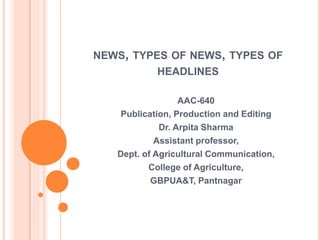
News
- 1. NEWS, TYPES OF NEWS, TYPES OF HEADLINES AAC-640 Publication, Production and Editing Dr. Arpita Sharma Assistant professor, Dept. of Agricultural Communication, College of Agriculture, GBPUA&T, Pantnagar
- 2. NEWS A news is what everyone wants to know about. Anything timely that interests a large number of persons and the best news is that which has the greatest interest for the greatest number. News is timely report of events, facts, opinions and interests about a significant no of people. News is an abstract concept whose shape changes as the interest of human change.
- 3. The definition of news items is dependent on: 1. The size of community. (Reader). 2. Periodicity of the publication. (Weekly, Daily). 3. Social character and economic.( base of the community). 4. Focus of attention or emphasis of the community. (Provincial city’s municipality election may not become headline in the newspapers of Delhi or Calcutta.
- 4. Inverted Pyramid Most important facts Next most important Next most important Next
- 5. Characteristics of a good Summary Lead The first paragraph of a news story contains the most important information. This is called the Summary Lead, because it summarizes the most important facts gathered about the story. •Briefest possible summary of a story, usually no more than 25 words. •Includes only those 5 Ws and 1 H that are important.
- 6. What are the Ws and H •Who •What •When •Where •Why •Whom •How
- 7. DIFFERENT TYPES OF NEWS Hard news Soft news
- 8. HARD NEWS Event oriented. Centred on “What, when, where and why.” Major thrust of newspaper is hard news. Hard news covers news on serious crime e.g terrorist attacks Politics, Disasters eg: an earthquake
- 9. SOFT NEWS Soft news are news about entertainment, human interest stories and less serious crime. More on analysis, reasons, background and interpretation. Mere account of events do not satisfy the readers. They would like to enter beneath the upper crust of hard news.
- 10. INGREDIENTS OF THE NEWS Timeliness: News must be timely and new. Not arouse interest if it is already known. Proximity: People are more interested in what happens in their village, town, country. Conflict: People gather in a street if and when there is fight. Conflicts of all kinds are part of life and make good copy. Prominence: What happens to important people makes news. Government action: The passing of law or other orders concerning general people cabinet meetings, parliament and assembly sessions, notifications about new rules regulations are news worthy.
- 11. NEWS VALUE Accuracy: Accuracy is basic to any news item. Balance: If you are writing controversy, give both sides of story. Objectivity: You should not mix your opinion in the story. Report only fact and other people’s opinions. Clarity: Your Introductory sentence should be short and in active voice. Ideal length of each para may be 3-4 lines containing one to three sentences to facilitate easy comprehension. Impact: Will it induce some changes somewhere for the better.
- 12. KINDS OF HEADLINES Banner head Crossline head Flush left head Side heads/ Flush right head Kicker (eyebrow)
- 13. BANNER HEAD Banner headlines are attention grabbers. They set the tone, and are used sparingly. The banner head is set the full-page width at the top of a news page to draw attention to the lead story of that particular page.
- 14. CROSSLINE HEAD It does not always span the full width of the page, but does cover all the columns of the story to which it pertains.
- 15. FLUSH LEFT HEAD The flush left head is a two- or three-line head with each line set flush left. The lines do not have to be equal in width or set full.
- 16. FEATURE HEADLINES Usually three words or more in length but do not have a subject or verb. Dollars for Scholars (article on scholarships) Cafeteria Blues (article on rule changes in cafeteria)
- 17. Hanging Indention: has at least three lines, second and third line indented. Teachers Need Bigger Increase In Wage Package
- 18. CROSS LINE: a single line of type filling the column or space. Example: (notice width) Wage increase breeds discontent
- 19. INVERTED PYRAMID The first line fills in the entire column, then uses less space as it gets to the bottom. Example: Two Spanish classes to host festivals for community in evenings
- 20. CENTERED HEADLINE this type of headline is centered above the column.
- 21. KICKER Kicker, also known as a tag line, is a line that introduces the headline, can be underlined for emphasis. Example: Cold weather hits… Temperature drops below freezing
- 22. HAMMER HEAD: Opposite of kicker. Example: Drowning in “Purple Rain” Storm delays Prince’s concert at Arena
- 23. SIDESADDLE HEADS: Places the head to the left of the story, rather than above. Example: Turkey Day: Pioneers regain Bell
- 24. RULES FOR WRITING SENTENCE HEADLINES: Strive to make each one an attention grabber. Make sure each head fills the space allotted. Avoid repetition of words or phrases. Use single rather than double quotation marks. Avoid using a semicolon in a one line head. Example: Principal makes presentation; discusses attendance policy Avoid beginning headline with a verb.
- 25. RULES FOR WRITING SENTENCE HEADLINES CONT. Use only well known abbreviations. (YMCA, NBA, NFL) Don’t begin headline with a number (spell out) Use information from your lead when writing a headline for a feature story. Use active voice. Use full names unless the person is well known.
- 26. DECK: a second headline under the first, smaller in size. Example: Pioneers down Lancers, 3-0, in muddy, defensive battle before standing-room crowd Win Clinches district berth
- 27. Thanks
